Proactive interface: Google suicide search page redesign
- Transfer
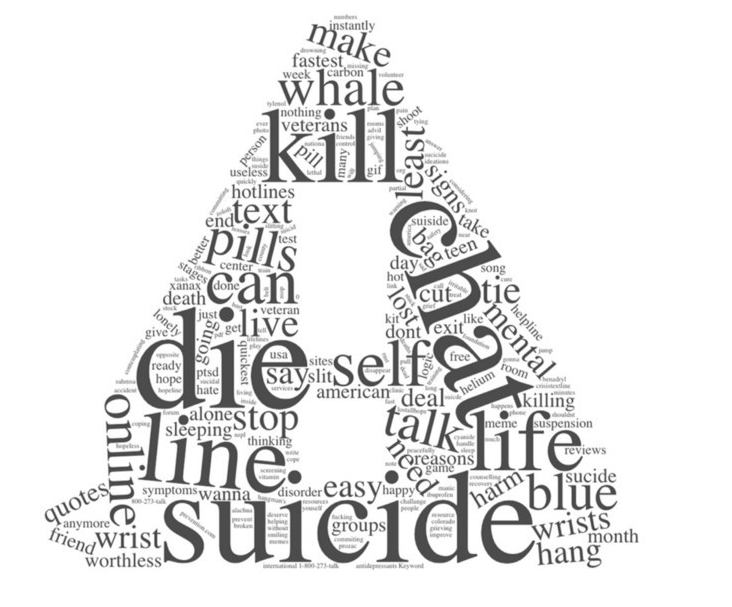
As a college student, I was one of the five who are prone to anxiety disorder and depression. The desperate desire to study well, search for work, relationships, just the feeling that I am “entering into adulthood” - all this merged into an avalanche of worries that swallowed me headlong (looking back, I understand that many of them were frivolous).
Once, in the first year of my studies, I had a particularly busy day - one of those days when the schedule was already full, and new problems and meetings all arrived and arrived. That night, I was completely exhausted in bed, but I could not close my eyes because of paranoia. Three hours later, having failed to fall asleep, I got out of bed and googled: "simple ways to die."
And here is what I saw:
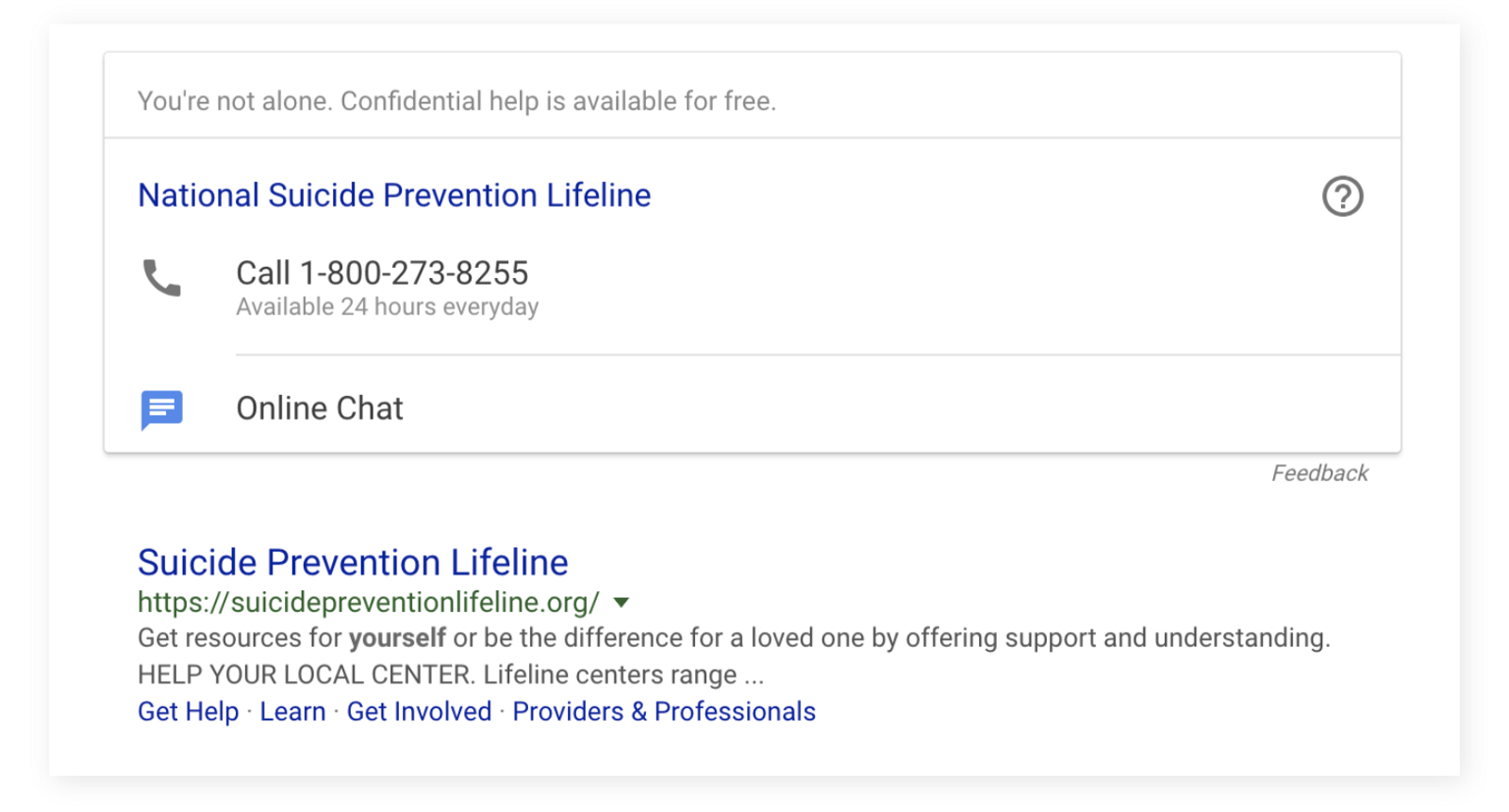
There is something to clarify. Yes, I suffered from a mild form of depression, but I did not have suicidal tendencies. This action was prompted, by and large, to irritation that reached unhealthy limits (moreover, exacerbated by lack of sleep), and not a serious intention to commit suicide. But even to me the words: “You are not alone; we provide free confidential assistance. Dial 1–800–273–8255 ”seemed very dry and breech. It is as if you had heard someone scream for help and in response would have stuck the psychologist's business card without even looking at the speaker.
Fortunately, I just let go of stinging remarks at the text and finally fell asleep. But I still can’t imagine how lightweight such support would have seemed to a person who is ready for anything to die. It is a lazy, mechanistic reaction and a fresh, watery sincerity.
1. The problem
I survived and life got better. However, I still could not forget how lifelessly the response sounded, which in theory should save lives. After a while, I returned to see if anything had changed.

Issue pages for suicidal intent. Clockwise: Google, Yahoo, Bing and Facebook.
Unfortunately, I saw only variations of the same scheme: simply providing contact numbers for hotlines. The ultimate goal here is to stop suicidal thoughts and convince the user to pick up the phone and call where they can help in the future. For this to happen, the user must:
- Perceive the information and realize that he needs help. At this stage, most people are already very deep in the labyrinth of gloomy thoughts. It is extremely difficult to impress them, and the phone number will definitely have no effect on them. (Barrier)
- Take the phone and dial the number. Physical limitations only add an extra step to the whole process. What if the phone is somewhere far away? (Barrier)
- Wait for a response from a specialist on the line. The caller will be greeted with automatically played recorded text. Personally, my answering machines always leave me feeling impersonal; a couple of times I even hung up the phone without having to wait until they connect me with a living person. (Barrier!)
But these users initially did not ask for help at all - they asked to tell them simple ways of suicide. If we limit ourselves to passively giving them a support offer as one of the options, this will not work. Instead, you need something personal, something that will resonate in them, so that they feel that there are people who care and the opportunity to get help.
2. Turn to the numbers
I used a couple of search traffic analysis tools to better understand the extent of the problem.
Google Trends: Defining Relevant Keywords and Trends
The Google Trends tool allows you to determine the popularity of certain keywords. It also provides lists of “Related Topics” and “Related Requests”, which are very useful for evaluating relevance and accuracy.
For example, as the first trend for analysis, I, of course, took “suicide”. However, similar queries that the system issued for him showed that the result is influenced by some viral queries, such as the movie “Suicide Squad” or an incident involving Logan Paul.
To get rid of these results, which distort the overall picture, I began to try more substantive queries, in the spirit of “how to commit suicide,” but in similar queries, references to sensational incidents from the media world were still mixed in, mainly news about celebrities that were tragically passed away.
Finally, I decided to completely abandon the word "suicide" and replaced the request with "how to commit suicide." In the bullseye - only requests related to mental illness and thoughts of suicide turned out to be similar now.

From the list I selected ten of the most popular queries that provide a search range for people with suicidal tendencies. Having summarized the data on them, I built a graph showing the dynamics of the group over the past five years.
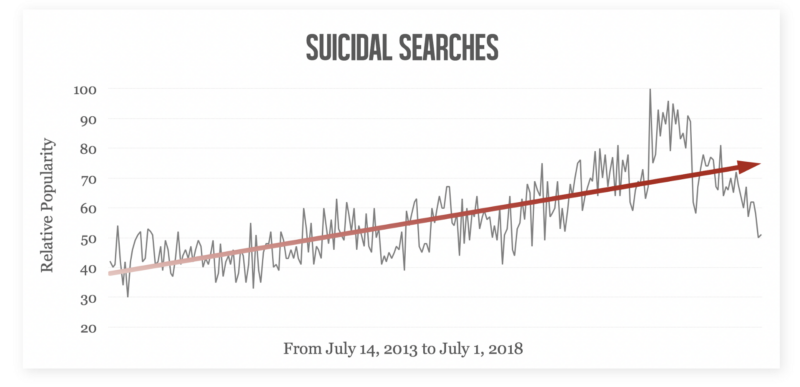
Search trends on suicide for 2013-2018
Undoubtedly, the number of depressive and suicidal requests is increasing with alarming constancy.
Ahrefs Keywords Explorer - looking for additional short keywords and checking statistics
AKE is a great tool that gives you access to accurate search metrics. First, I checked the performance of those ten shorts that I already selected in Google Trends. AKE showed that each of these requests is part of a larger thematic group (for example, “how to tie a loop”, “hate life” and “kill me”). Having expanded all the groups, I received as many as hundreds of child queries related to the topic of suicide and depression.

After that I analyzed all thematically related queries. The results were staggering: from the USA alone, 611,000 suicidal requests are received monthly (this is more than the entire population of Wyoming). Even worse, only 40,000 people click on the first link in the search results (Suicide Prevention Lifeline). Of course, this says little about conversion, and yet 6% of the clicks for the first result on the page is so small that it suggests that there should be more effective ways to help people when they are on the verge and are about to make a decision that may cost them their lives.
According to a study conducted in 2017, 89% of people who survived a suicide attempt say they acted under the influence of the moment. 52% of survivors believe that they would give up their intentions if they received support and care. In the light of these depressing statistics, it becomes clear: there is nothing more to wait, you need to figure out how to pacify the impulsive craving for suicide and push people to seek help.
3. Sources of inspiration
The first thing that came to my mind was a pilot project to prevent suicide, which was implemented in Korea. There is a bridge in Seoul, from where those who decide to take their own lives are thrown into the water almost daily. Someone from the townspeople proposed a brilliant solution: stick banners with words of support on the railing. Anyone who wants to jump willfully read them.
Some phrases were quotes from famous people, others were written in a colloquial style used by close friends and family members: “How are you, buddy?”, “It's cool here today,” “have you already eaten?” The city administration commented on it this way: “We did not want to put obstacles in front of people, but to change the flow of their thoughts in the right direction.”
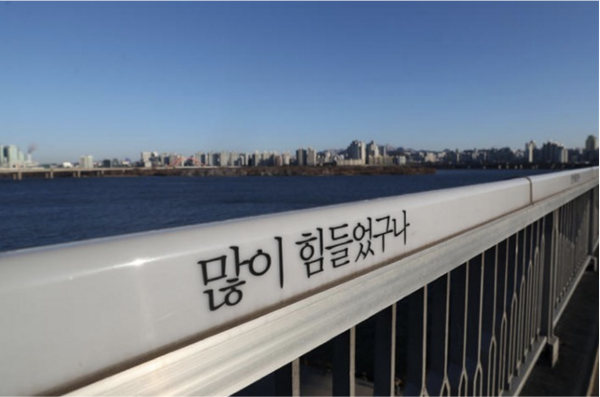
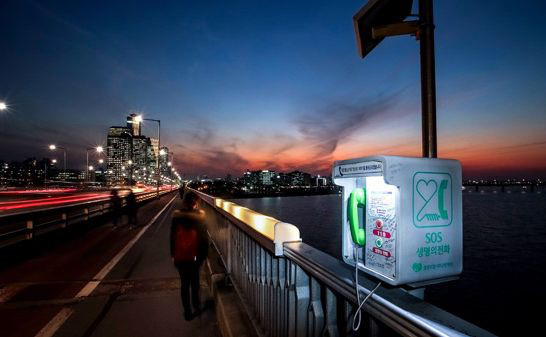
Photos of the bridge in Seoul: a banner with a quote (“You must have gone through a lot,” written in the style of a wise old man) and a booth with a telephone for calling the hot line
Reading the banners and moving forward along the bridge, the person finally comes to telephone booth with access to the hot line: with its help, you can directly contact a psychologist. The whole experience, starting from the moment when a person in a depressed state rises to the bridge and ending with the decision to call the hotline under the influence of encouraging words, was planned perfectly.
Criticism
Depression has one very important feature: everyone faces different problems and what worked for one, in the other case, can have the opposite effect. On the railing of the bridge came across phrases that can be called controversial:
- “Do you want to go downstairs and have coffee with your friends?” - These words should cause a feeling of peace by reminding you of something pleasant and ordinary. But they will negatively affect those who have no or practically no friends, as well as those who cannot afford a glass of coffee due to money problems.
- “And that too will pass. Think of your troubles as a gust of wind ”- The message here is that difficulties sooner or later pass and everything is getting better. But it will negatively affect those who are terminally ill or burdened with overwhelming debts.
Many also expressed concern about the long-term effect and scope of the project. The inscriptions really helped to drive away thoughts of suicide at the very moment when a person is standing on the bridge. But whether he would receive the necessary support afterwards was unclear. Without prolonged work with a psychologist, suicidal thoughts may return at any time, and quotes may not have such a strong effect a second time. This initiative works as an emergency painkiller, but does not always eradicate the virus itself.
Decision
An online search website is the most suitable platform in order to convince the user to seek help and thereby provide more effective preventive measures. In addition, by making the content interactive and constantly developing it, we can recreate and improve the thoughtful experience that was built in the project with the bridge. In the absence of physical limitations, we can also provide a significantly greater degree of personalization by referring to the individuality of the user, which will allow solving chronic problems that were typical of many methods in the past.
4. Basic components

We identify the sources of suicidal thoughts to understand users.
This is the first step to personalizing content. You need to know your enemies - by identifying the reasons for the actions of users, we will be able to show more sympathy for them. According to a study by the Korean Ministry of Health, the leading causes of suicide attempts include: mental illness (31%), further relationships (23%), conflict situations (14.1%), financial difficulties (10.5%) and health problems (7.5%).
I wrote out as many reasons as possible, based on both research and personal experience, and sorted them into five main categories - very broad, so that any victim could feel involvement in at least one of them.
- Relations (death of loved ones, quarrels)
- Achievements (study, career)
- Society (gender inequality, sexual identity, midlife crisis)
- Physiology and Psychology (physical and mental illness, addiction, violence)
- Emotions (guilt, regret about decisions made)
Responsive design for interaction and engagement
The interface, which automatically delivers content, leaves a feeling of facelessness because the response is too uniform (and the sterility of the design also leaves its mark). On the contrary, an interface that responds to user actions creates the feeling that they are being taken care of, they are delving into their problems. An open conversation is much more effective than giving out information unilaterally when it comes to creating a personalized message.
Universal quote to attract attention
I needed some powerful motto that could at first glance suppress thoughts of suicide, even for a short time, and capture the user's attention. The quote I chose first was based on the idea that although death may seem to be the only way out, in fact, if you get the proper support, there are always better options.
“There is always a better choice than taking your own life”
This text was also chosen in order to arouse interest - the user would naturally want to continue the interaction to find out which "best choice" was in question.
The second quote suddenly occurred to me when I was already finalizing the design. The scene from the original comic book series about Deadpool led me to this idea (by the way, thanks to Cheongo, a colleague who recommended them to me). In it, Deadpool rescues a woman who was ready to jump from the roof, with the help of her signature black humor. Having gone down, she asks Deadpool to take her home, but instead he brings her to a rehabilitation center with the following words: “I have enough intelligence to understand that there isn’t enough for him to help you. But these people will do better. ”
It was like an electric discharge. I realized how arrogant my first quote might seem. Neither I nor my computer can fully understand the problems of people, let alone point to the right solution. A search engine is just an intermediary that brings users to professionals who are truly capable of telling them the way out. Based on this, I decided that a quote would be much more appropriate:
“Our search engine does not know the answers to the most difficult questions in your life. But we can help you find them. ”
By adopting such a Socratic approach and recognizing that we are not omnipotent, we can finally pave the way for professional help for the user, instead of thoughtlessly giving out unqualified advice. In addition, when you openly talk about your imperfection, this creates a more friendly and psychologically comfortable atmosphere.
Personalization of the text to avoid misunderstandings
A serious drawback of the initiative with the bridges of Seoul was that some quotes might not be suitable for specific situations. This can be avoided by asking the user what exactly makes him think of suicide, and selecting content based on his answer.
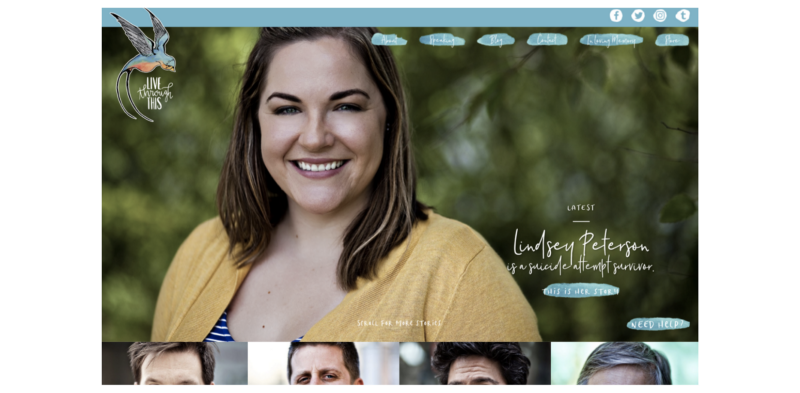
www.livethroughthis.org - a resource where people with depression and suicidal thoughts can read the stories of those who have experienced suicide
Success stories to demonstrate a “better way out”
Any words will sound more convincing when they come from people who have experienced the same difficulties, as the user. By reading life stories that resemble his own experience, the user will be motivated to follow the example of survivors and seek help to survive the tragedy.
5. Design
We save the DNA of Google-design
In this case, I am doing a redesign, rather than launching a new service. The principle to which I attach particular importance can be formulated as follows: when reworking an existing design, treat the original principles with respect. The essence of design is not to “make beautiful.” Design is a manifestation of the company's philosophy, its basic values, which are affirmed on the basis of many years of research and testing.
Initially, I planned to display the content in full screen for a deeper immersion. However, I was very familiar with the Google card design, which breaks the content into thematic blocks, and decided to follow the same pattern. Using the developer tools in Google Chrome, I carefully studied the search results grid and tried to recreate it in Sketch.

I also took the very font that Google uses on search results pages - Roboto, only played a little with the size and style, hoping that the small differences would not be too striking. Symbols and icons I chose from the Google Material Design library, in order to withstand constancy here too.


“Blue is the warmest color”
In full accordance with the name of the film (look, if there is a desire to sob), blue has a relaxing effect on our psyche, it is no coincidence that it is used more actively in therapy than all other colors. Blue color relieves stress throughout the body and positively affects patients with anxiety disorder and depression.
Given the mood of the audience, I wanted to exclude aggressive shades. I chose not too saturated colors, calm, but not cloudy (like the summer sky in San Francisco) to create a sense of peace among victims of suicidal thoughts. For the buttons that needed to be highlighted, I selected the shades a little bit more to create contrast.


6. Experience "from and to"
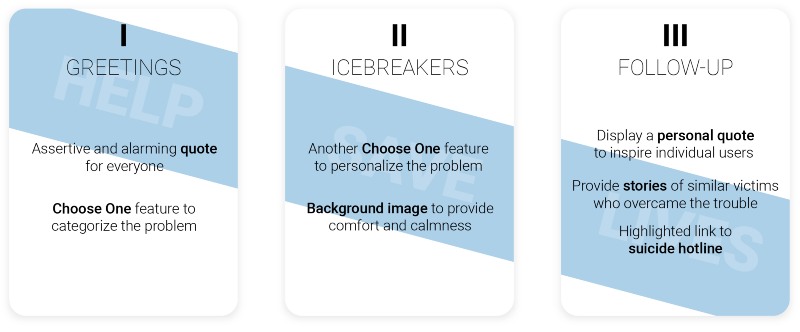
Three-block diagram: Greeting (universal quote + category selection) - Contact (positive background image + another request for information) - Response (personalized quote + survivor history + contact information)
Greeting

This is the very first screen that users will see and respond to after they enter a suicidal request.
A quote will be placed above that should attract the attention of any user (“There is always a better way ...” or “Our search engine ...”). Below, the user will be asked in an affable tone to choose one of the five main reasons for thoughts of suicide. Categories are very broad and abstract, but if you mouse over the icon, for each drop-down list of examples of specific situations. In the lower right corner there will be contact information so that the user can ask for help at any time.
Contact
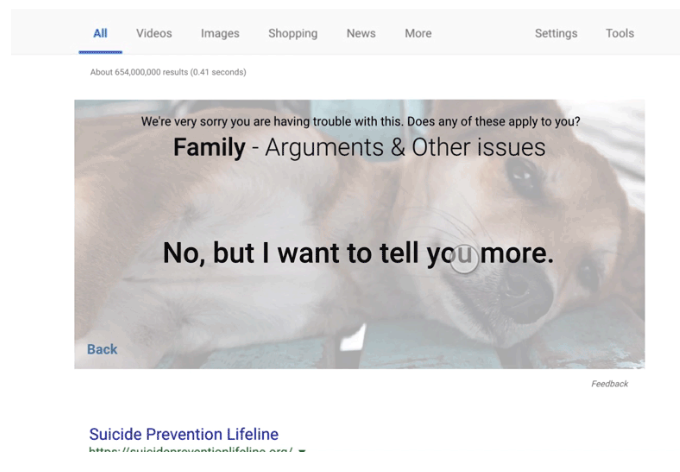
Inside the selected category, the user will be asked to narrow the spectrum by specifying the type of problem that torments him. If it seems to him that he has chosen the wrong category, there is always an option to return to the beginning. If nothing of what he sees causes associations with his own situation, he can click on the last item: “No, but I want to tell more.” In this case, he will be redirected to a page with a text box, where he can freely state his difficulties - I firmly believe that just throwing out your feelings outside, you can reduce the level of stress to some extent.
Response
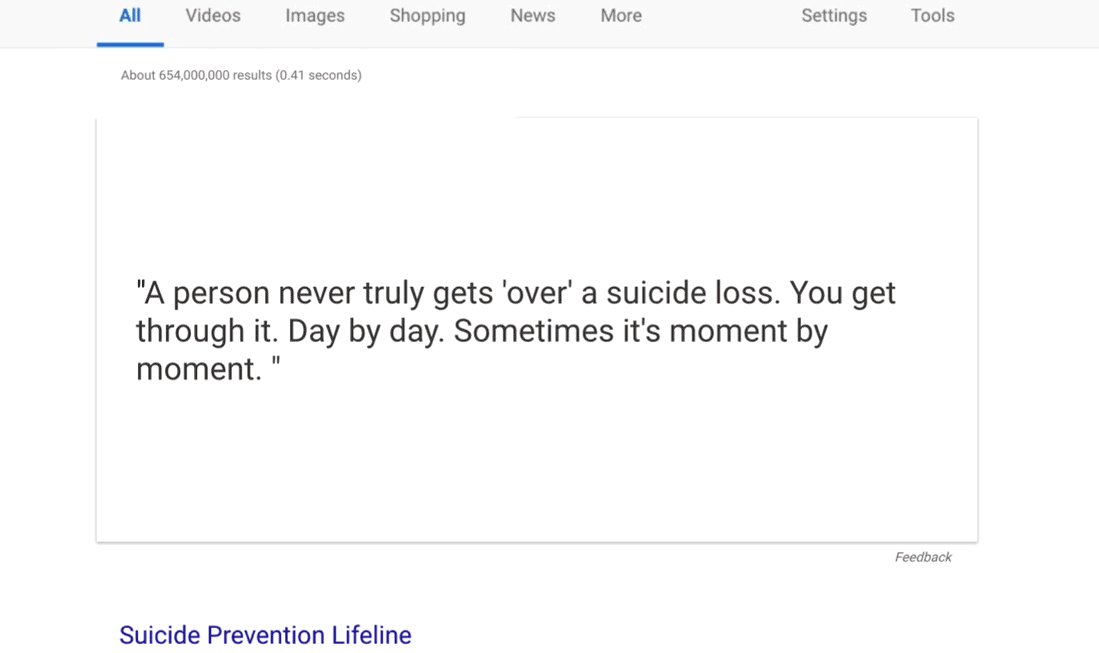
Based on what points the user selected in the previous steps, targeted content will be selected for him: an encouraging quote and the story of a person who has experienced something like that. At the end of the trip, the user will again see contact information and hotline phones, now highlighted brighter. For those who chose “No, but I want to tell you more”, the system will give a more neutral quote and story that will suit a wide range of circumstances.
7. Conclusion and plans for the future
I wanted to design an automatic response that would leave a feeling of genuine concern. But with computers, things are more complicated with sincerity than with people (at least for now). Recognizing this fact was an important step - it allowed me to focus on what computers do better than ours: processing variable values and displaying dynamic content. If you properly combine the strengths of people and machines, you can overcome the physical barriers faced by previous preventive methods and provide sincere support to a huge number of people. The new interface, acting as a modest intermediary between the dark and light sides, will lead users to the most reliable path that we have - the path of human mutual assistance.
Over the past couple of months, I have gathered a ton of suicide information from online sources. However, the project is still very far from perfect, and I would not be at all surprised if a lot of errors and shortcomings are revealed in it. But in my opinion, he is not bad as a starting point. I would be happy to work closely with experts in psychology, design, human-computer interaction and related fields to identify project weaknesses, discuss how to improve it, and possibly save more lives.
